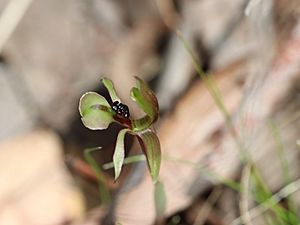Broad-lip bird orchid facts for kids
Quick facts for kids Broad-lip bird orchid |
|
|---|---|
 |
|
| Chiloglottis trapeziformis near Acton in the A.C.T. | |
| Scientific classification | |
| Synonyms | |
|
The Chiloglottis trapeziformis, also known as the broad-lip bird orchid, diamond ant orchid, or dainty bird-orchid, is a special type of orchid. It grows naturally only in south-eastern Australia. This orchid has two thin leaves and a unique flower. The flower can be greenish, purplish, or brownish. It has a shiny black, ant-like part called a callus on its diamond-shaped labellum. This orchid has also been seen, though rarely, in New Zealand.
Contents
Discover the Broad-Lip Bird Orchid
The broad-lip bird orchid is a plant that grows from the ground. It lives for many years, but its leaves die back each year. It has two leaves that are about 30 to 80 mm (1 to 3 inches) long and 10 to 25 mm (0.4 to 1 inch) wide.
What Does the Flower Look Like?
A single flower grows on a stem that is about 80 to 140 mm (3 to 6 inches) tall. The flower itself is about 12 to 16 mm (0.5 to 0.6 inches) long and 6 to 8 mm (0.2 to 0.3 inches) wide. It can be green, purple, or brown.
The top part of the flower, called the dorsal sepal, looks like a small spatula. It is about 11 to 13 mm long. The side sepals are thin and curve downwards. All three sepals have a tiny tip at the end.
The petals are shaped like long rectangles and are about 8 to 15 mm long. They turn downwards near the base of the flower. The most interesting part is the labellum. It stands upright and is shaped like a diamond, about 7 to 12 mm long. A shiny black, ant-like structure covers one-fourth of its top surface. This orchid usually blooms from August to November.
Naming the Broad-Lip Bird Orchid
The Chiloglottis trapeziformis was officially named in 1877. It was named by a person called Robert D. FitzGerald. He wrote about it in his book, Australian Orchids. The first plant he described was found near Liverpool.
Where Does This Orchid Grow?
The broad-lip bird orchid is quite common and can be found in many different places. It likes sheltered spots. You can find it in south-eastern Queensland, eastern New South Wales, and eastern Victoria.
There is also a small group of these orchids in south-eastern South Australia. You can also find them scattered in Wynyard, Launceston, Flinders Island, and Great Dog Island in Tasmania. Sadly, a small group that used to grow in a pine forest near Levin in New Zealand has now disappeared.
Protecting the Broad-Lip Bird Orchid
In Tasmania, the Chiloglottis trapeziformis is considered "endangered." This means it is at risk of disappearing forever. It is protected under the Threatened Species Protection Act 1995 in Tasmania.

